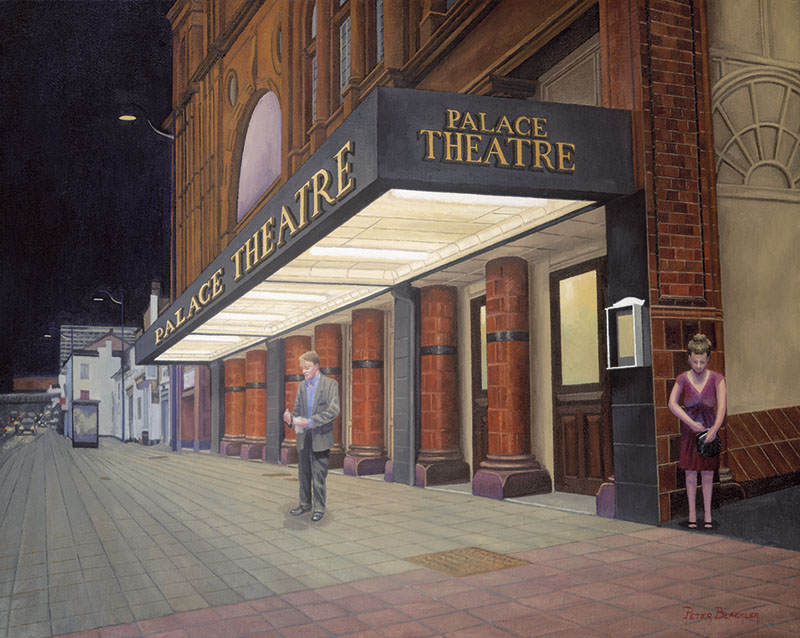Plymouth Series
A series of oil paintings created by the artist Peter Blackler portraying images of Plymouth, Devon, UK.
The project has so far included some of the more well known historical buildings and places , however it also includes some unfamiliar settings. For the viewer this may leave them feeling they are seeing a different side to Plymouth.
The Plymouth Series
'The Duke of Cornwall Hotel'
Built in 1863, the Duke of Cornwall Hotel was the first luxury hotel in Plymouth, and was described by Sir John Betjeman “as one of the nation’s best examples of Victorian architecture’. Today the generous proportions of the hotel evoke the grace of years gone by, and awaken the feelings of nostalgia.
Surviving the Plymouth Blitz in WW2, the hotels close links to port and railway station saw guests such as Ernest Shackleton and his party the night prior to their Antarctic expedition over a hundred years ago, to Anne Ziegler and Webster Booth, Laurel and Hardy, Charlie Chaplin, Bing Crosby, Suzi Quatro, Lionel Blair and Dame Janet Fookes, many of which have signed the visitors book.
'The Esplanade'
Portrayed within this painting is the beautiful grade II listed Georgian terrace known as 'The Esplanade'.
Built in 1836, the terrace was designed by architect George Whitewick and from its location it has unrivaled panoramic views overlooking Plymouth Hoe toward Drakes Island, Mount Edgcumbe, Mount Batten, Plymouth Sound and beyond.
The original image is painted in oils on canvas.
'Grand Parade'
This historical Victorian terrace known as ‘Grand Parade’ overlooks Plymouth West Hoe waterfront is featured in one of the oil on canvas paintings.
'Radford Road/Grand Parade'
This impressive Victorian residence stands at the corner of ‘Radford Road’ and ‘Grand Parade’ in Plymouth’s West Hoe. From its unique position its faces onto the open water of Plymouth Sound; encapsulating Drakes Island, Mount Edgecombe and Plymouth Breakwater.
This oil on canvas shows the structure and detail of the building.
'Elliot Terrace'
This oil painting shows the elegant Grade II listed buildings of Elliot Terrace.
Erected in the 19th century this important group of elegant terraces & villas designed by Foulston and his pupil George Wightwick, feature in Pevsners, 'The Buildings of England'. The history of this terrace is notable, once the homes of both the British writer Sir Arthur Conan Doyle, who lived in No 6, and Nancy Astor, the 1st woman Member of Parliament, who owned No 3.
'Notte Street and Armada way'
Part of Abercrombie and Paton Watson’s post war Plymouth design this Grade II listed building designed by Curtis Green was formerly the Barclays Bank chambers. Located on the corner of Notte Street and Armada Way it is in a prime location within the city centre. As an architect Green designed many banks and financial houses in London, as well as the exterior of the Dorchester Hotel. This elegance Portland stone building is the focus of an image.
'Palace Theatre rooftops, Union Street'
Built in 1898, the Palace theatre in Plymouth Union Street was designed by William Arber of Wimperis & Arber from Sackville Street, London, and cost £95,000 to erect.
More recognisable from its decorative frontage this painting portrays the buildings rear rooftops.
'Devonport Bank'
The old Midland Bank in former Fore Street was one of two original pre-World War 2 buildings in Devonport’s South Yard enclave to survive the bombings. As part of the Devonport regeneration the facade was dismantled stone by stone and reconstructed.
'Grand Parade - The White House'
Build in the 1850s Grand Parade was the first great terrace of houses built on the waters edge at West Hoe. Located on the corner of Pier Street and Grand Parade is this 3 storey domed building featured within the painting.
'Palace Theatre'
Built for Livermore Brothers Court Minstrels, the Palace Theatre opened in 1898 as a music hall, and adjoined the Great Western Hotel. Over the years this Grade II listed building was a theatre and nightclub and played host to entertainment greats Gracie Fields, Laurel and Hardy, Charlie Chaplin, and Frankie Howerd. Its elaborate terracotta Northern Renaissance frontage it is an imposing sight in Plymouth’s Union Street.
'Grand Parade - Girl with dog'
Represented within the oil on canvas painting is the Grand Parade a famous historical Victorian terrace overlooking Plymouth West Hoe waterfront.
'The Dingles Building, Royal Parade'
Opened on September 1st 1951, the Dingles Building (now House of Fraser) was designed by Thomas Tait and was one of the earliest post-war constructions in Plymouth. Its prominent position within the city centre marks the boundaries of Armada Way, Royal Parade and New George Street. It was the first major post-war department store to open in Britain, and the first in the South West to be fitted with escalators.
'Civic Centre'
Originally designed by Hector Stirling, the Civic centre was an integral building of Plymouth’s post war design. Started in 1959 it took 3 years to construct and was opened by H.M. the Queen on July 26th 1962. The building itself is constructed in three perpendicular, cantilevered blocks, and the main fourteen storey tower of Council offices. Represented within the painting is the council chamber next to Notte Street.












